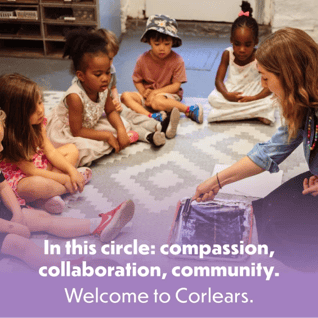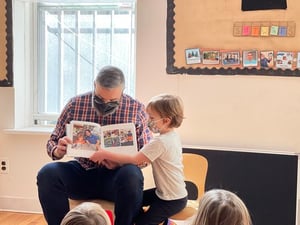The development of oral language is one of children’s most impressive accomplishments during the first five years of life (Genishi, 1988; Isbell, Sobol, Lindauer & Lowrance, 2004). Oral language development is a large indicator of future literacy success and early exposure to literacy is a vital component of oral language development in young children. Through the use of Interactive Read Alouds parents can help enhance the oral language skills children require for ongoing literacy development.
What is an Interactive Read Aloud? An Interactive Read Aloud is when a series of purposeful questions and activities are embedded into the story being read so that children become active and engaged participants.
5 simple ways you can bring Interactive Read Alouds home to continue growing and supporting your child’s oral language development:
1. Making Predictions
Before your interactive read aloud, preview the book you are reading and find a place where you can ask stop and ask your child to make a prediction.
-
“What do you think will happen next?”
-
“If we added one more page to the end of this book what would it be about?”
2. Vocabulary
Before your interactive read aloud preview the book and select 1-3 vocabulary words or phrases from the book that you can highlight or define during reading. Using the pictures in the story and sometimes the text to support understanding, ask your child if they can try to figure the meaning of the word.
-
“Let’s read that sentence again, using the words in the story and the pictures, what do you think that word or phrase means?”
3. Asking Meaningful Questions
During your interactive read aloud stop and ask your child questions about the text. These questions should be relatable to your child and build on the knowledge they already know.
-
“What would you have done if you were the character?”
-
“Why did the character make that choice?”
-
“What in the story made you think that?”
-
“How can you tell?”
4. Making Connections
During your interactive read aloud stop and ask your child to draw a connection to the story you are reading. It can be about how the character is feeling, the situation they are in, or as simple as where the story is taking place.
-
“How do you think the character is feeling? Have you ever felt that way? Tell me more about that.”
-
“How are you like/different than this character?”
-
“Where do you think the characters are?”
-
“Have you ever been there?”
5. After Reading Questions
After your interactive read aloud stop and ask follow-up questions to the story. “W” questions after the story encourage children to make inferences and support your child’s ability to answer broader explanation questions.
-
“Tell me about this story.”
-
“What was your favorite part?”
-
“Where did the story take place?”
-
“How did you know that?”
These simple adjustments when reading encourage your child to become verbal participants in the story. By asking open-ended meaningful questions, encouraging children to make connections or predication, and introducing new vocabulary, you are encouraging your child to access their language as well as their prior knowledge in order to answer. This works to build and extended your child’s oral language abilities and is instrumental in increasing their overall literacy development.
An Interactive Read Aloud provides an avenue for parent and child to begin experimenting with discussions surrounding words and pictures in books, thus leading to the use of complex sentences and a more extensive vocabulary. Kaderavek and Justice (2002), agree that story reading can foster communication opportunities for young children, as they discuss the text and illustrations.
This deliberate and systematic approach toward reading stories is not only beneficial to the complexity of oral language but is constructive to a young child’s literacy development overall. Children who are exposed to Interactive Read Alouds not only show an increase in oral language development but an improvement in comprehension skills, letter and symbol recognition, a sense of story structure and develop a more positive attitude towards reading. Morrow (1985) supports this notion by highlighting that active participation in literary experiences enhances the development of comprehension, oral language, and a sense of story. Implementing and fostering Interactive Read Alouds in the home can produce formidable literacy experiences that positively effect oral language development and the overall literacy development of young children.
References
-
Isbell, R., Sobol, J., Lindauer., & Lowrance, A. (2004). The effects of storytelling and story reading on the oral language complexity and story comprehension of young children. Early Childhood Education Journal, 32(3), 157-163.
-
Kaderavek, J. & Justice, L. (2002). Shared storybook reading as an intervention
-
context: Practices and potential pitfalls. American Journal of Speech-Language Pathology, 11, 395-406
-
Morrow, L.M. (1985). Retelling stories: A strategy for improving young children’s comprehension, concept of story structure, and oral language complexity. The Elementary School Journal, 85(5), 646-661.








